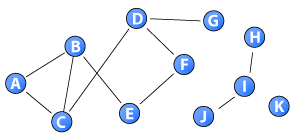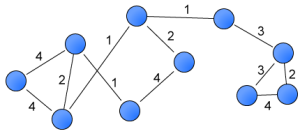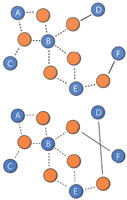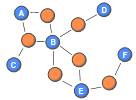Posts tagged ‘undirected networks’
 A paper called “For the few not the many? The effects of affirmative action on presence, prominence, and social capital of women directors in Norway” that I have co-authored will be published in the Scandinavian Journal of Management. Governments have implemented various affirmative action policies to address vertical sex segregation in organizations. A gender representation law was introduced in Norway, which required public limited companies’ boards to have at least 40 percent representation of each sex by 2008. This law acted as an external shock, and this paper aims to explore its effects. In particular, it explores the gender bias, the emergence and sex of prominent directors, and directors’ social capital. We utilize data from May 2002 to August 2009 to analyze these aspects. The implied intention of the law was to create a larger pool of women acting as directors on boards, and the law has had the effect of increasing the representation of women on boards. However, it has also created a small elite of women directors who rank among the top on a number of proxies of influence.
A paper called “For the few not the many? The effects of affirmative action on presence, prominence, and social capital of women directors in Norway” that I have co-authored will be published in the Scandinavian Journal of Management. Governments have implemented various affirmative action policies to address vertical sex segregation in organizations. A gender representation law was introduced in Norway, which required public limited companies’ boards to have at least 40 percent representation of each sex by 2008. This law acted as an external shock, and this paper aims to explore its effects. In particular, it explores the gender bias, the emergence and sex of prominent directors, and directors’ social capital. We utilize data from May 2002 to August 2009 to analyze these aspects. The implied intention of the law was to create a larger pool of women acting as directors on boards, and the law has had the effect of increasing the representation of women on boards. However, it has also created a small elite of women directors who rank among the top on a number of proxies of influence.
Continue Reading September 30, 2010 at 4:02 pm
 A paper called “Node centrality in weighted networks: Generalizing degree and shortest paths” that I have co-authored will be published in Social Networks. Ties often have a strength naturally associated with them that differentiate them from each other. Tie strength has been operationalized as weights. A few network measures have been proposed for weighted networks, including three common measures of node centrality: degree, closeness, and betweenness. However, these generalizations have solely focused on tie weights, and not on the number of ties, which was the central component of the original measures. This paper proposes generalizations that combine both these aspects. We illustrate the benefits of this approach by applying one of them to Freeman’s EIES dataset.
A paper called “Node centrality in weighted networks: Generalizing degree and shortest paths” that I have co-authored will be published in Social Networks. Ties often have a strength naturally associated with them that differentiate them from each other. Tie strength has been operationalized as weights. A few network measures have been proposed for weighted networks, including three common measures of node centrality: degree, closeness, and betweenness. However, these generalizations have solely focused on tie weights, and not on the number of ties, which was the central component of the original measures. This paper proposes generalizations that combine both these aspects. We illustrate the benefits of this approach by applying one of them to Freeman’s EIES dataset.
Continue Reading April 21, 2010 at 10:37 am
 A key node centrality measure in networks is closeness centrality (Freeman, 1978; Wasserman and Faust, 1994). It is defined as the inverse of farness, which in turn, is the sum of distances to all other nodes. As the distance between nodes in disconnected components of a network is infinite, this measure cannot be applied to networks with disconnected components (Opsahl et al., 2010; Wasserman and Faust, 1994). This post highlights a possible work-around, which allows the measure to be applied to these networks and at the same time maintain the original idea behind the measure.
A key node centrality measure in networks is closeness centrality (Freeman, 1978; Wasserman and Faust, 1994). It is defined as the inverse of farness, which in turn, is the sum of distances to all other nodes. As the distance between nodes in disconnected components of a network is infinite, this measure cannot be applied to networks with disconnected components (Opsahl et al., 2010; Wasserman and Faust, 1994). This post highlights a possible work-around, which allows the measure to be applied to these networks and at the same time maintain the original idea behind the measure.
Continue Reading March 20, 2010 at 1:03 pm
 Many network dataset are by definition two-mode networks. Yet, few network measures can be directly applied to them. Therefore, two-mode networks are often projected onto one-mode networks by selecting a node set and linking two nodes if they were connected to common nodes in the two-mode network. This process has a major impact on the level of clustering in the network. If three or more nodes are connected to a common node in the two-mode network, the nodes form a fully-connected clique consisting of one or more triangles in the one-mode projection. Moreover, it produces a number of modeling issues. For example, even a one-mode projection of a random two-mode network with same number of nodes and ties will have a higher clustering coefficient than the randomly expected value. This post represents an attempt to overcome this issue by redefining the clustering coefficient so that it can be calculated directly on the two-mode structure. I illustrate the benefits of such an approach by applying it to two-mode networks from four different domains: event attendance, scientific collaboration, interlocking directorates, and online communication.
Many network dataset are by definition two-mode networks. Yet, few network measures can be directly applied to them. Therefore, two-mode networks are often projected onto one-mode networks by selecting a node set and linking two nodes if they were connected to common nodes in the two-mode network. This process has a major impact on the level of clustering in the network. If three or more nodes are connected to a common node in the two-mode network, the nodes form a fully-connected clique consisting of one or more triangles in the one-mode projection. Moreover, it produces a number of modeling issues. For example, even a one-mode projection of a random two-mode network with same number of nodes and ties will have a higher clustering coefficient than the randomly expected value. This post represents an attempt to overcome this issue by redefining the clustering coefficient so that it can be calculated directly on the two-mode structure. I illustrate the benefits of such an approach by applying it to two-mode networks from four different domains: event attendance, scientific collaboration, interlocking directorates, and online communication.
September 11, 2009 at 12:00 am
 tnet is a package written in R that can calculate weighted social network measures. Almost all of the ideas posted on this blog are related to weighted networks as, I believe, taking into consideration tie weights enables us to uncover and study interesting network properties. Not only are few social network measures applicable to weighted networks, but there is also a lack of software programmes that can analyse this type of networks. In fact, there are no open-source programmes. This hinders the use and development of weighted measures. tnet represents a first step towards creating such a programme. Through this platform, weighted network measures can easily be applied, and new measures easily implemented and distributed.
tnet is a package written in R that can calculate weighted social network measures. Almost all of the ideas posted on this blog are related to weighted networks as, I believe, taking into consideration tie weights enables us to uncover and study interesting network properties. Not only are few social network measures applicable to weighted networks, but there is also a lack of software programmes that can analyse this type of networks. In fact, there are no open-source programmes. This hinders the use and development of weighted measures. tnet represents a first step towards creating such a programme. Through this platform, weighted network measures can easily be applied, and new measures easily implemented and distributed.
The content of this post has been integrated in the
tnet manual, see
Software.
June 12, 2009 at 12:00 am
 In this post, I extend the Weighted Rich-club Effect by suggesting and testing a different null model for the scientific collaboration network (Newman, 2001). This network is a two-mode network, which becomes an undirected one-mode network when projected. In the paper, we compared the observed weighted rich-club coefficient with the one found on random networks. The random networks were constructed by a null model defined for directed networks when prominence was based on node strength. Therefore, we created a directed network from the undirected scientific collaboration network by linking connected nodes with two directed ties that had the same weight. The null model consisted in reshuffling the tie weights attached to out-going ties for each node. However, this local reshuffling broke the weight symmetry of the two directed ties between connected nodes. The null model proposed in this post is based on the randomisation of the two-mode network before projecting it onto a one-mode network. By randomising before projecting, we are able to randomise a network while keeping the symmetry of weights.
In this post, I extend the Weighted Rich-club Effect by suggesting and testing a different null model for the scientific collaboration network (Newman, 2001). This network is a two-mode network, which becomes an undirected one-mode network when projected. In the paper, we compared the observed weighted rich-club coefficient with the one found on random networks. The random networks were constructed by a null model defined for directed networks when prominence was based on node strength. Therefore, we created a directed network from the undirected scientific collaboration network by linking connected nodes with two directed ties that had the same weight. The null model consisted in reshuffling the tie weights attached to out-going ties for each node. However, this local reshuffling broke the weight symmetry of the two directed ties between connected nodes. The null model proposed in this post is based on the randomisation of the two-mode network before projecting it onto a one-mode network. By randomising before projecting, we are able to randomise a network while keeping the symmetry of weights.
May 29, 2009 at 12:00 am
I have now completed my Ph.D. at the School of Business and Management of Queen Mary College, University of London. My Ph.D. programme was defined around a number of projects, which drew on, and extended, recent theoretical and methodological advances in network science. The projects that were concerned with weighted networks and longitudinal networks were outlined and critically discussed in my thesis (Structure and Evolution of Weighted Networks). The entire thesis, except Appendix C which is outdated, is available on the Publication > Thesis-page.
Acknowledgements
The theme of this thesis is interdependence among elements. In fact, this thesis is not just a product of myself, but also of my interdependence with others. Without the support of a number of people, it would not have been possible to write. It is my pleasure to have the opportunity to express my gratitude to many of them here.
For my academic achievements, I would like to acknowledge the constant support from my supervisors. In particular, I thank Pietro Panzarasa for taking an active part of all the projects I have worked on. I have also had the pleasure to collaborate with people other than my supervisors. I worked with Vittoria Colizza and Jose J. Ramasco on the analysis and method presented in Chapter 2, Kathleen M. Carley on an empirical analysis of the online social network used throughout this thesis, and Martha J. Prevezer on a project related to knowledge transfer in emerging countries. In addition to these direct collaborations, I would also like to thank Filip Agneessens, Sinan Aral, Steve Borgatti, Ronald Burt, Mauro Faccioni Filho, Thomas Friemel, John Skvoretz, and Vanina Torlo for encouragement and helpful advice. In particular, I would like to thank Tom A. B. Snijders and Klaus Nielsen for insightful reading of this thesis and many productive remarks and suggestions. I have also received feedback on my work at a number of conferences and workshops. I would like to express my gratitude to the participants at these.
On a social note, I would like to thank John, Claudius, and my family for their continuing support. Without them I would have lost focus. My peers and the administrative staff have also been a great source of support. In particular, I would like to extend my acknowledgements to Mariusz Jarmuzek, Geraldine Marks, Roland Miller, Jenny Murphy, Cathrine Seierstad, Lorna Soar, Steven Telford, and Eshref Trushin.
May 15, 2009 at 12:00 am
 This post highlights a number of methods for projecting both binary and weighted two-mode networks (also known as affiliation or bipartite networks) onto weighted one-mode networks. Although I would prefer to analyse two-mode networks in their original form, few methods exist for that purpose. These networks can be transformed into one-mode networks by projecting them (i.e., selecting one set of nodes, and linking two nodes if they are connected to the same node of the other set). Traditionally, ties in the one-mode networks are without weights. By carefully considering multiple ways of projecting two-mode networks onto weighted one-mode networks, we can maintain some of the richness contained within the two-mode structure. This enables researchers to conduct a deeper analysis than if the two-mode structure was completely ignored.
This post highlights a number of methods for projecting both binary and weighted two-mode networks (also known as affiliation or bipartite networks) onto weighted one-mode networks. Although I would prefer to analyse two-mode networks in their original form, few methods exist for that purpose. These networks can be transformed into one-mode networks by projecting them (i.e., selecting one set of nodes, and linking two nodes if they are connected to the same node of the other set). Traditionally, ties in the one-mode networks are without weights. By carefully considering multiple ways of projecting two-mode networks onto weighted one-mode networks, we can maintain some of the richness contained within the two-mode structure. This enables researchers to conduct a deeper analysis than if the two-mode structure was completely ignored.
May 1, 2009 at 12:00 am
 A paper called “Clustering in Weighted Networks” that I have co-authored will be published in Social Networks. Although many social network measures exist for binary networks and many theories differentiate between strong and weak ties, few measures have been generalised so that they can be applied to weighted networks and retain the information encoded in the weights of ties. One of these measures is the global clustering coefficient, which measures embeddedness or, more specifically, the likelihood of a triplet being closed by a tie so that it forms a triangle. This article proposes a generalisation of this key network measure to weighted networks.
A paper called “Clustering in Weighted Networks” that I have co-authored will be published in Social Networks. Although many social network measures exist for binary networks and many theories differentiate between strong and weak ties, few measures have been generalised so that they can be applied to weighted networks and retain the information encoded in the weights of ties. One of these measures is the global clustering coefficient, which measures embeddedness or, more specifically, the likelihood of a triplet being closed by a tie so that it forms a triangle. This article proposes a generalisation of this key network measure to weighted networks.
Continue Reading April 3, 2009 at 12:00 am
A paper called Prominence and control: The weighted rich-club effect that I have co-authored was published in Physical Review Letters (PRL). In this paper, we proposed a new general framework for studying the tendency of prominent nodes to direct their strongest ties toward each other.
Continue Reading December 12, 2008 at 12:00 am
 Networks are the cornerstone of this blog, therefore I have decided to make the first post my definition of a network and a few basic network measures.
Networks are the cornerstone of this blog, therefore I have decided to make the first post my definition of a network and a few basic network measures.
The content of this post has been integrated in the
tnet manual.
November 28, 2008 at 12:00 am
 A paper called “For the few not the many? The effects of affirmative action on presence, prominence, and social capital of women directors in Norway” that I have co-authored will be published in the Scandinavian Journal of Management. Governments have implemented various affirmative action policies to address vertical sex segregation in organizations. A gender representation law was introduced in Norway, which required public limited companies’ boards to have at least 40 percent representation of each sex by 2008. This law acted as an external shock, and this paper aims to explore its effects. In particular, it explores the gender bias, the emergence and sex of prominent directors, and directors’ social capital. We utilize data from May 2002 to August 2009 to analyze these aspects. The implied intention of the law was to create a larger pool of women acting as directors on boards, and the law has had the effect of increasing the representation of women on boards. However, it has also created a small elite of women directors who rank among the top on a number of proxies of influence.
A paper called “For the few not the many? The effects of affirmative action on presence, prominence, and social capital of women directors in Norway” that I have co-authored will be published in the Scandinavian Journal of Management. Governments have implemented various affirmative action policies to address vertical sex segregation in organizations. A gender representation law was introduced in Norway, which required public limited companies’ boards to have at least 40 percent representation of each sex by 2008. This law acted as an external shock, and this paper aims to explore its effects. In particular, it explores the gender bias, the emergence and sex of prominent directors, and directors’ social capital. We utilize data from May 2002 to August 2009 to analyze these aspects. The implied intention of the law was to create a larger pool of women acting as directors on boards, and the law has had the effect of increasing the representation of women on boards. However, it has also created a small elite of women directors who rank among the top on a number of proxies of influence.  A paper called “Node centrality in weighted networks: Generalizing degree and shortest paths” that I have co-authored will be published in Social Networks. Ties often have a strength naturally associated with them that differentiate them from each other. Tie strength has been operationalized as weights. A few network measures have been proposed for weighted networks, including three common measures of node centrality: degree, closeness, and betweenness. However, these generalizations have solely focused on tie weights, and not on the number of ties, which was the central component of the original measures. This paper proposes generalizations that combine both these aspects. We illustrate the benefits of this approach by applying one of them to Freeman’s EIES dataset.
A paper called “Node centrality in weighted networks: Generalizing degree and shortest paths” that I have co-authored will be published in Social Networks. Ties often have a strength naturally associated with them that differentiate them from each other. Tie strength has been operationalized as weights. A few network measures have been proposed for weighted networks, including three common measures of node centrality: degree, closeness, and betweenness. However, these generalizations have solely focused on tie weights, and not on the number of ties, which was the central component of the original measures. This paper proposes generalizations that combine both these aspects. We illustrate the benefits of this approach by applying one of them to Freeman’s EIES dataset. A key node centrality measure in networks is closeness centrality (Freeman, 1978; Wasserman and Faust, 1994). It is defined as the inverse of farness, which in turn, is the sum of distances to all other nodes. As the distance between nodes in disconnected components of a network is infinite, this measure cannot be applied to networks with disconnected components (Opsahl et al., 2010; Wasserman and Faust, 1994). This post highlights a possible work-around, which allows the measure to be applied to these networks and at the same time maintain the original idea behind the measure.
A key node centrality measure in networks is closeness centrality (Freeman, 1978; Wasserman and Faust, 1994). It is defined as the inverse of farness, which in turn, is the sum of distances to all other nodes. As the distance between nodes in disconnected components of a network is infinite, this measure cannot be applied to networks with disconnected components (Opsahl et al., 2010; Wasserman and Faust, 1994). This post highlights a possible work-around, which allows the measure to be applied to these networks and at the same time maintain the original idea behind the measure. This post highlights a number of methods for projecting both binary and weighted two-mode networks (also known as affiliation or bipartite networks) onto weighted one-mode networks. Although I would prefer to analyse two-mode networks in their original form, few methods exist for that purpose. These networks can be transformed into one-mode networks by projecting them (i.e., selecting one set of nodes, and linking two nodes if they are connected to the same node of the other set). Traditionally, ties in the one-mode networks are without weights. By carefully considering multiple ways of projecting two-mode networks onto weighted one-mode networks, we can maintain some of the richness contained within the two-mode structure. This enables researchers to conduct a deeper analysis than if the two-mode structure was completely ignored.
This post highlights a number of methods for projecting both binary and weighted two-mode networks (also known as affiliation or bipartite networks) onto weighted one-mode networks. Although I would prefer to analyse two-mode networks in their original form, few methods exist for that purpose. These networks can be transformed into one-mode networks by projecting them (i.e., selecting one set of nodes, and linking two nodes if they are connected to the same node of the other set). Traditionally, ties in the one-mode networks are without weights. By carefully considering multiple ways of projecting two-mode networks onto weighted one-mode networks, we can maintain some of the richness contained within the two-mode structure. This enables researchers to conduct a deeper analysis than if the two-mode structure was completely ignored.  Networks are the cornerstone of this blog, therefore I have decided to make the first post my definition of a network and a few basic network measures.
Networks are the cornerstone of this blog, therefore I have decided to make the first post my definition of a network and a few basic network measures.


 RSS feed
RSS feed